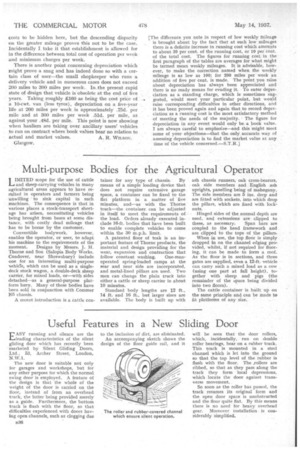Multi-purpose Bodies for the Agricultural Operator
Page 46

If you've noticed an error in this article please click here to report it so we can fix it.
LIMITED scope for the use of cattle LA and sheep-carrying vehicles in many agricultural areas appears to have resulted in operators and fanners being unwilling 'to sink capital in such machines. The consequence is that in various places a stock-transport shortage has arisen, necessitating vehicles being brought from bases at some distance, with costly dead mileage that has to be borne by the customer.
Convertible bodywork, however, enables the operator, or user, to adapt his machine to the requirements of the moment. Designs by Messrs. J. H. Thorne and Son (Salopia Body Works, Condover, near Shrewsbury) include one for an interesting multi-purpose vehicle, which can be used as a singledeck stock wagon, a double-deck sheep carrier, for mixed loads, or—with sides detached—as a general-purpose platform lorry. Many of these bodies have been sold in conjunction with Cornmer N5 chassis.
A recent introduction is a cattle con
tainer for any type of chassis. By means of a simple loading device that does not require extensive garage space, a container can be fixed to the flat platform in a matter of five minutes, and—as with the Thorne truck—the container, can be adjusted in itself to meet the requirements of the load. Orders already executed include 16-ft. bodies that have been built to enable complete vehicles to come within the 30 m.p.h. limit.
A patented floor of teak is an important feature of Thorne products, the material and design providing for the wear, expansion and contraction that
follow constant washing. One-manoperated spring-loaded ramps at the rear and near side are incorporated, and metal-lined pillars are used. Two men can change the plain truck into either a cattle or sheep carrier in about 10 minutes.
Standard body lengths are 12 ft., 14 ft. and 16 ft., but iarger sizes are available. The body is built up with ash chassis runners, oak cross-bearers, oak side members and English ash uprights, panelling being of mahogany. The side members are 5 ins, deep and are fitted with sockets, into which drop the pillars, which are fixed with locknuts.
Hinged sides of the normal depth are used, and extensions are clipped to these, as necessary. Span bars are coupled to the head framework and are clipped to the tops of the pillars.
When in use, the top floor is simply dropped in on the channel edging provided, whilst, if not required for flooring, it can be made to form a roof. As the floor is in sections, and three gates are supplied, even a 12-ft.-vehicle can carry such a mixed load as a cow (using one part at full height), together with sheep and pigs (the remainder of the space being divided into two floors). "
The cattle container is built up on the same principle and can be made to fit platforms of any size.




















































































